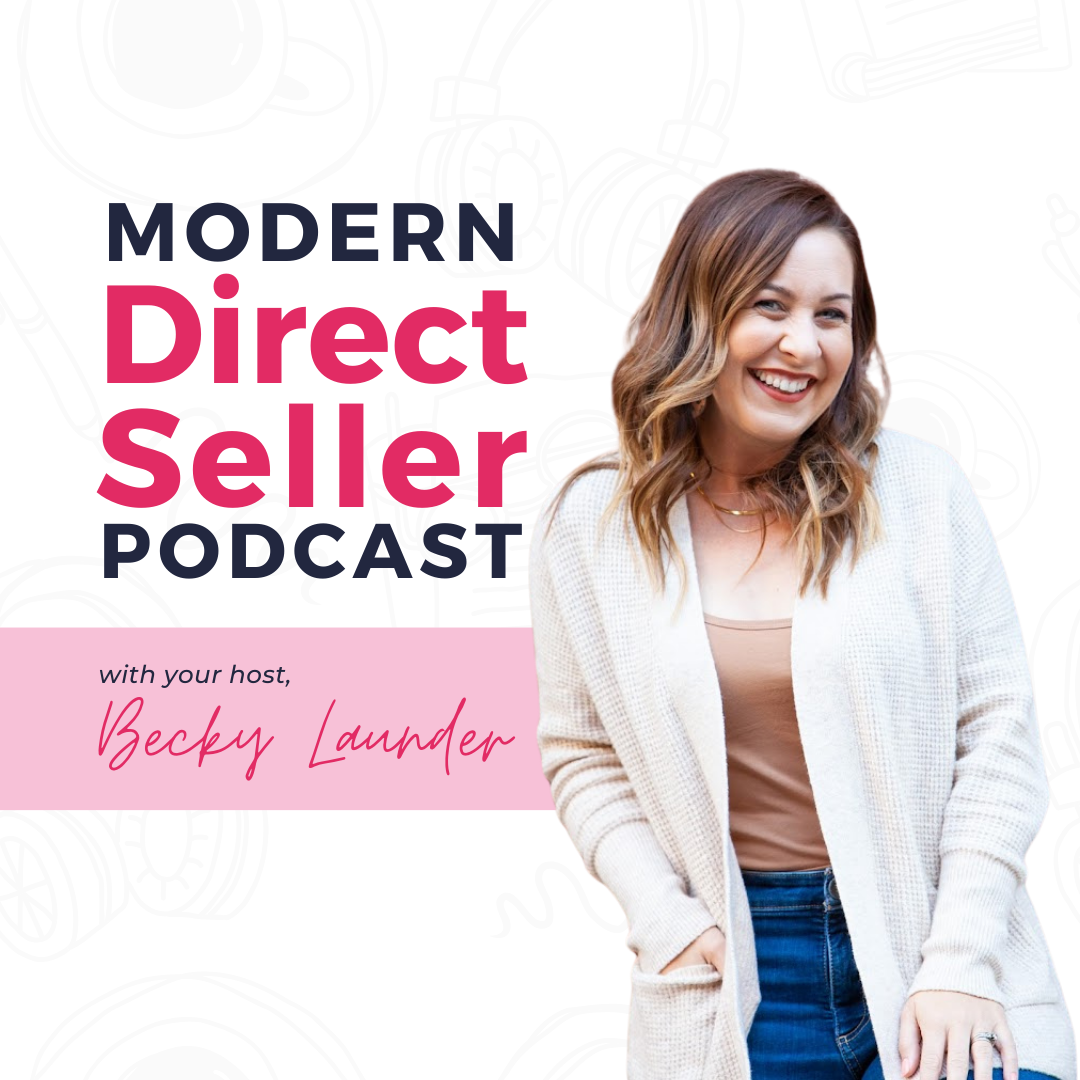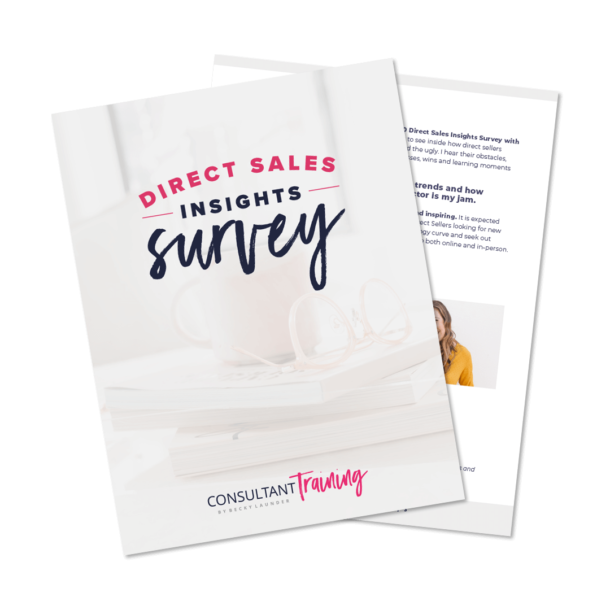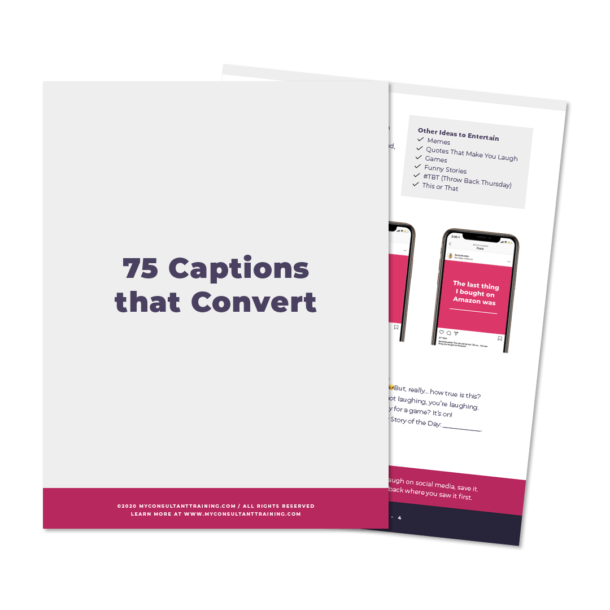It’s Challenge Week over at Modern Direct Seller, and today we are talking about utilizing bold and actionable sales strategies—particularly when it comes to online parties. Tech, social media, and even our customers continue to grow more sophisticated, so in 2024, we need to better partner with our hosts, bring value to our guests, and collect leads for the future if we want our parties to be effective. Luckily, it only takes a few simple changes to run a party that brings in new business!
The Modern Direct Seller Challenge is officially open for the spring! It’s a free, five-day trial full of tips to grow your business, so save your seat at ModernDirectSeller.com/Challenge.
Time based notes:
- 0:37 Modern Direct Seller Challenge
- 2:03 Parties as a primary strategy
- 4:06 Build a relationship with your host
- 6:52 Party where the people are
- 9:40 RSVP required
- 12:22 Less content, more conversation
- 14:16 Partner with your host
Five Tips to Update Your Online Parties
It’s Challenge Week here at Modern Direct Seller, so over on the Modern Direct Seller Podcast, we’re talking about utilizing bold and actionable sales strategies—particularly when it comes to online parties.
I know that many of you are part of a party plan company, meaning your company has host rewards or an emphasis on doing parties as a primary sales strategy. So, you know that the landscape of online parties has changed tremendously over the years. I remember the good old days. When we got started doing Facebook parties, we were actually running them in events on Facebook. You would invite a few people, they’d get all the notifications, you would post a couple of company-created graphics and shopping links, and people would go shop. They used to be a 20-minute thing one night at 6:00 PM. Now, of course, parties have become more and more sophisticated. It’s really turned into multiple days, with live videos and short-form videos and messaging and scripts. It’s gotten complicated, but it really doesn’t need to be that complicated.
So, if you are a Party Powerhouse, and you love running parties, I want to share a little bit around what’s working, so you can take these ideas and apply them to your own business.
The first best practice when it comes to parties here in 2024 is to build a relationship with your host. I know many of you are like, “I haven’t had a host for a while. I’ve just been running my own parties.” Which is great! But, the beauty of parties and why it makes it worth the effort is when you have a host, they are able to invite their social network to participate in your party. That means a whole bunch of leads being handed over to you from your host. So, it’s super important to build a relationship with that host, to connect with them, and to really learn a lot about them—because they’re also a great candidate for somebody that might want to join your team. So, host coaching is still very much required and needed. But, before you can even get to host coaching, you’re going to have to ask if people want to host a party.
And, here’s the thing friends: Nobody wants to get sold to at a party. So, if you have not reframed your parties to be value-driven, or an event where somebody can learn something or take something away, then we’re missing the boat here. Nobody wants to go to a party just to hear about things that they have to go buy. We want to really show up and provide value.
So, Number One: host coaching required. Build that relationship with that host. They are so generously inviting you into their social circle to give you the opportunity to share what you have to offer. So, you really want to link arms with them and make sure that you’re closely aligned and getting them, of course, all the freebies and host rewards, but also creating an incredible experience for their guests.
Okay, so let’s talk about that experience. I want you to think about who you’re serving and using that as a way to choose the type of party that you’re offering. I like to say, “You want to party where the people are,” right? We don’t want to create a party in a Facebook group when our host does not have people on Facebook. We need to come up with another option to meet the host and the guests where they’re at. So, that definitely needs to be part of the conversation with the host before you even pitch a type of party to them.
With some of the changes that we’re seeing on social media, I think we’re going to see a wider variety of parties than we’ve seen in a long time. I’ve done a lot of training on a Party in a Post, which is a single post where all the action is happening in the comments. I’ve also done a lot of training on a Shop and Scroll, where people head over to a landing page; you can build that out in Canva, in Project Broadcast, in Boards, on Oh, My Hi… I am also seeing tremendous engagement over on business Pages. I know that we’ve been running parties in groups for a long time, but this might be your friendly nudge from the universe to go try to run a pop-up party on a business Page, a personal profile Page, or even on your host profile Page.
I think this is the time to experiment a little. We really need to keep things fresh and exciting, not only to keep up with some of the algorithm changes and tech changes that we’re seeing, but also to honor people’s time. People don’t want to spend an entire week in your party; I hate to break it to you. They want to get in and out and get the information that they need. So, let’s think about how we bring the party to those guests.
So, that’s Number Two: When you think about party format, think about where those people are, and how you can go to them.
Okay, that brings me to Number Three: an RSVP is absolutely required in 2024. Long gone are the days of setting up a Facebook group, clicking the “Invite” button, and inviting 2,000 people to a party. We really want to be intentional about asking for an RSVP prior to giving the party link out. That’s the critical piece. You want to find out who’s going. Once they respond back and say, “Yes, I would like to go to the party,” just then, you say, “Great, this is where you can join us,” and you send them the link to the landing page you created, the Party in a Post you created, the business Page you’re running it on—wherever that might be.
And, make sure you’re collecting those RSVPs, because as soon as the host has done the hard work of getting a yes from that guest, that lead is handed over to you as the direct seller. As soon as they’re handed over to you, that is somebody that would be a potential customer of yours, and I want you to serve them and love on them, regardless if they show up for the party. So, it’s really important that you have their contact information.
That’s what the RSVP is: Them, going to a Google form, and putting their information in, and then saying, “Yes, I’ll be there.” Them, sending a message to the host, “Yes, I’m coming,” and she or he introduces them to you, and so you have a direct connection with them on social media. Maybe it’s even your host just tagging them in a post, and then you reaching out and connecting with them directly. But, you want to make sure that you have that RSVP and a way to reach out to them and talk to them directly, especially if you can do that outside of social media. That’s going to serve you really, really well.
For Number Four: Let’s get into content. I know that many of you have party scripts that are 20 pages long. Or, maybe you have it saved in your favorite scheduling tool, like CinchShare, and there’s 47 posts. It’s too much. I know that we want to tell everyone about everything that’s in our catalog, and let them know all the features and benefits and amazing things our products have to offer. But, your company provided you with a website and a catalog that covers everything. Your event should be a sampling of that. It should add your brand and your personality, and give people a taste of what they have to offer when they get to your website. You do not need to cover every single product or every single product category as part of your party. Keep it short and focused. Less content and more conversations.
So, the content that you’re sharing as part of your party needs to create conversation. It needs to ask curious questions and gather information about your guests, so you can take that into a one-to-one conversation. You already have their contact info, because they RSVPed. You want to get it into that one-on-one conversation, and then you can provide personal recommendations and solutions just for them. So, keep the party short and sweet, and allow for it to be self-paced, so a party guest can pop in at any point and get the information that they’re looking for.
Finally, Number Five: I want you to think about your host as your partner in crime. I want you to be so in alignment with your host that they are sharing what’s happening with the party across their social channels. So, if you’re running a party in a group, they still have a shopping link, so they can share that on their personal profile. They can share that in their Stories. They can share that on a completely different platform—maybe over on Instagram, right? Some people are only looking at Stories. Some people are only looking at Reels. Some people are only in Messenger. Not everyone is going to see everything if you just keep it to the party place. You want that host to be able to have the tools and the resources to go out there and share it more broadly, so maybe Aunt Susie from Idaho sees that link and clicks on it and ends up placing an order.
So, consider these five tips as you revamp you parties in 2024! Remember: Parties don’t have to be complicated. They can be straightforward, and when they’re done right, they’re a great way to bring in new leads that you then turn into customers, hosts, and new teammates.
Show sponsored by CinchShare: The #1 social media scheduler for direct sellers and online creators, and they’re offering our listeners a free 30-day trial with code GAMECHANGER! Get started through the app or by visiting CinchShare.com.









0 Comments